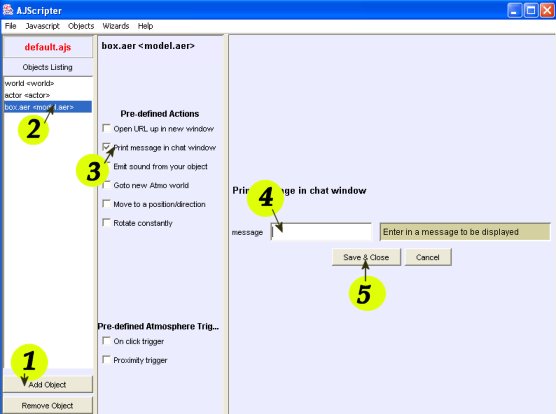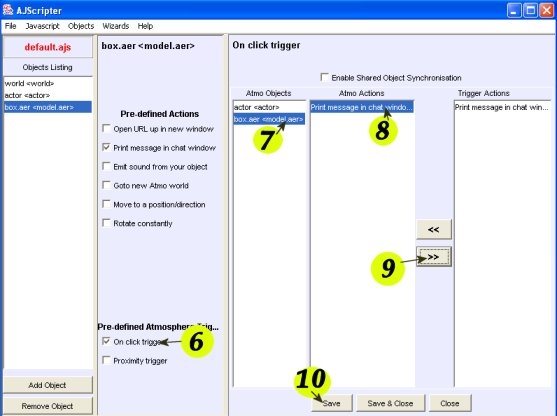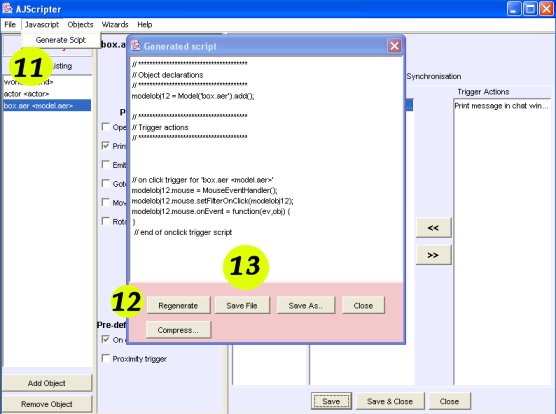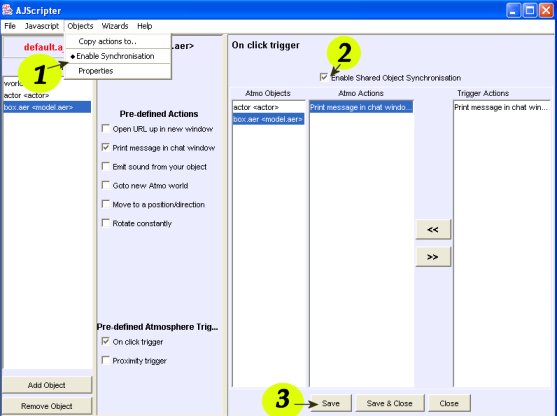| Tutorials
-> AtmoScripter -> Help How do i start? Begin by downloading the ajscripter.zip or ajscripter.rar. Thus far, AJScripter has been compiled to run on Windows only. If you have another operating system and have a Java JDK version installed on your machine, you can also run the application using the ajscripter.jar file. Unzip to a particular folder and run the ajscripter.exe. You ought to see the picture below:
To being creating a new javascript file, click on the File->New Project menu button. Lets run through a sample scenario to help you get started! Scenario 1 Say you wish to add a new atmosphere Model.aer to your Atmosphere world. With this Model, you wish to attach a message to it so that anytime a user clicks on it, the message prints in the chat box. Step 1 -- Define An Action! The action in this instance is to "print messages in the chat box". We set this up in AJScripter as follows:
1. Click the Add Object button. A window will popup. Specify the
type of object you wish to add (in this case, it is a "Model.aer")
and click "ok". The model we wish to add is named "box.aer". What have we done so far? We've simply specified an "Action". There are two types of object interaction concepts with AJScripter - "Actions" and "Triggers". Actions behave a particular way in the world, and Triggers cause the action to execute. Next step, specifying a "Trigger" for our Action. Step 2 -- Define a Trigger!
6. Click to enable the "On click trigger" check box. A new panel
will open up on the right hand side. Done! You have now set your trigger up. What is left? Having AJScripter auto-generate the javascript for us that you will use for your Atmosphere world. Step 3 -- Auto-Generate Script
11. From the menu bar, select Javascript->Generate. A new window
will pop up. Currently, it is empty.
Actions and Triggers In the sample Scenario 1, we saw how to add a simple action and trigger to an object. So trigger = box.aer (onclick) It is possible in AJScripter to assign different actions to different triggers. For example, trigger = sphere.mtx (proximity) And so forth. Play around with it and see what you can do!
Multi-User synchronisation AJScripter allows multi-user synchronisation via Shared Objects in Atmosphere. Basically, this mean that if "synchronisation" is enabled, other users within the world will be able to see what actions have been triggered from within your world (and vice versa). To enable synchronisation, it is a quick 3 step process:
1. In the menu bar, click Objects->Enable Synchronisation. Make
sure the little dot next to the name is on - this means that object
synchronisation is ON. Now, auto-regenerate & save your code - instant synchronisation via shared objects! Please note: For multi-user synchronisation capability within an Atmosphere world, you will need to have specified in your world the "Adobe Community Server". This might be typically something like "yacp://atmosphere.adobe.com".
Trouble? If you are having any troubles with things not mentioned on this page such as :
There are a range of reading materials out there. I'd start with http://www.roce.org/articles.html or go to the Adobe Forums and ask a question :)
|




